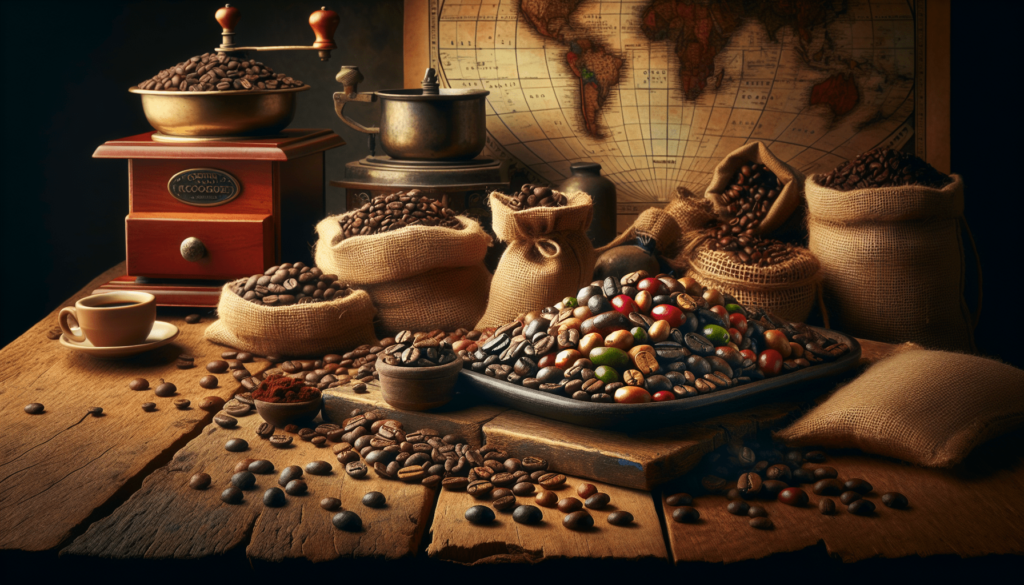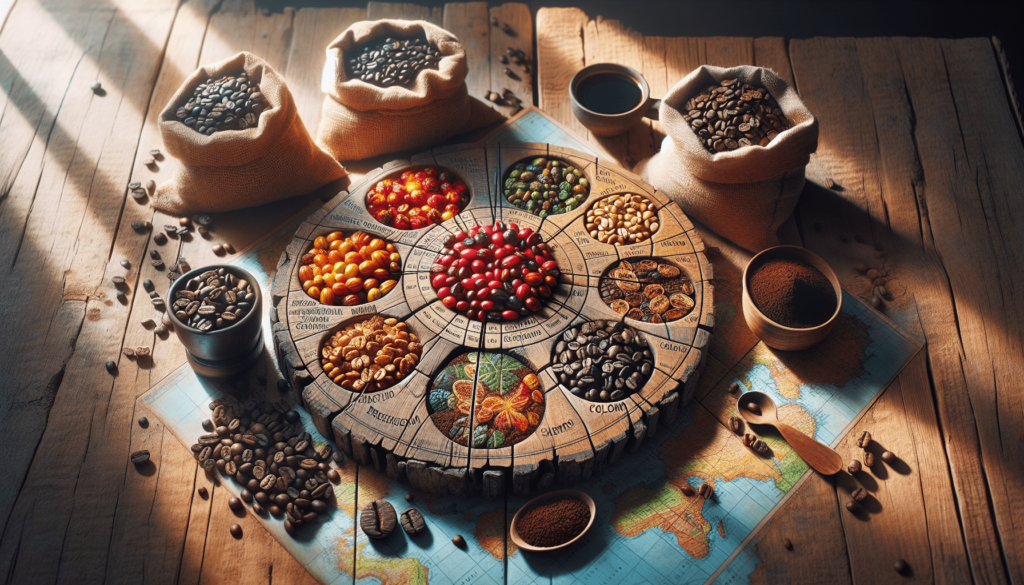What do you think about the journey your morning cup of coffee takes before it reaches your hands? It’s fascinating to realize that each sip you enjoy is the result of a long process that starts far away from your coffee cup. Let’s take a captivating tour of coffee bean origins around the globe and unfold the rich history and unique characteristics of coffee from different regions.

The Global Coffee Journey
Coffee is one of the most beloved beverages worldwide, consumed by millions every day. Its journey begins in tropical climates where the right conditions for coffee cultivation thrive. Did you know that the ideal temperature for growing coffee ranges from 60°F to 70°F? Humidity, rainfall, and altitude all play crucial roles in the flavor profiles of your favorite brew.
The Coffee Plant: Arabica vs. Robusta
Before we travel to the coffee bean origins, it’s important to understand the two main types of coffee plants: Arabica and Robusta.
| Feature | Arabica | Robusta |
|---|---|---|
| Flavor | Mild, complex with fruity notes | Strong, bitter, earthy flavors |
| Caffeine | Approximately 1.5% caffeine | Approximately 2.5% caffeine |
| Growing Altitude | Prefers higher elevations (2,000-6,000 ft) | Grows at lower altitudes (200-2,000 ft) |
| Yield | Lower yield per plant | Higher yield per plant |
| Region | Predominantly grown in Latin America, parts of Africa | Popular in Africa, Indonesia, Brazil |
Understanding these two types is crucial, as they set the stage for regional flavor differences and growing practices.
Africa: The Birthplace of Coffee
Ethiopia – The Coffee Birthplace
Ethiopia is often referred to as the birthplace of coffee, as many legends tell of its discovery by a goat herder named Kaldi. It’s believed that he noticed how energized his goats became after eating the coffee cherries from the shrubs. This led to the preparation of the first coffee drinks.
In Ethiopia, coffee is more than just a beverage; it’s ingrained in the culture. Traditional coffee ceremonies involve roasting green beans, grinding them, and brewing coffee in a special pot called a Jebena. The result is an aromatic experience, showcasing the unique fruity and floral notes that Ethiopian coffees possess.
Kenya – The Distinctively Bold Flavor
Kenya is renowned for producing some of the highest-quality Arabica coffee beans. The country’s high altitudes, along with volcanic soil, lend themselves to a vibrant acidity and bold flavor. Importantly, Kenyan coffee is well-structured, often exhibiting berry-like and citrus notes.
Typically, coffee from Kenya is grown on small farms, where growers focus on quality. The beans are often processed using the washed method, which cleans the beans and enhances their bright, fruity characteristics.
Central America: The Heart of Flavor Diversity
Guatemala – The Varietal Paradise
Guatemala is celebrated for its rich and diverse coffee-growing regions, each producing unique flavor profiles. Here, you’ll find Volcanic soil that contributes to the coffee’s complexity, alongside a welcoming climate.
In Guatemala, coffee farms cultivate distinct varietals like Bourbon and Typica, which, combined with different processing methods, yield a delightful array of flavors. You might find notes of chocolate, caramel, and spices in Guatemalan coffee. Plus, the commitment to sustainability and fair trade practices makes this region a favorite among conscientious coffee drinkers.
Costa Rica – A Focus on Quality
Known for its “strictly high-grown” coffee, Costa Rica has a reputation for prioritizing quality over quantity. Arabica beans flourish in the high-altitude regions, producing balanced cups with vibrant acidity and a sweet undertone. Costa Rican coffee often features bright, fruity flavors, making it a popular choice among coffee enthusiasts.
The country’s coffee plantations are committed to sustainable farming practices, ensuring that while you enjoy your coffee, you’re also supporting environmental sustainability.
South America: The Coffee Giants
Colombia – Coffee Known as “Liquid Gold”
Colombia is one of the largest coffee producers in the world, and its beans are known for their smooth taste and mild flavor. The country benefits from varying altitudes, which help cultivate exceptional coffee. Colombian coffee often presents a sweet, caramel-like flavor, accompanied by a pleasant acidity.
Additionally, Colombia has a well-established coffee-growing culture. Farmers work together in cooperatives, focusing on ethical practices and ensuring that the farmers receive fair prices for their hard work. Thus, every cup of Colombian coffee supports local communities.
Brazil – The World’s Coffee Powerhouse
As the largest coffee producer globally, Brazil has earned a significant place in the coffee industry. The country produces approximately one-third of the world’s coffee. Brazilian coffee often features a nutty, chocolatey flavor, which can vary based on the region and growing conditions.
Brazil’s diverse climate allows the cultivation of both Arabica and Robusta beans. The beans are often processed using the natural method, which imparts a unique flavor profile that is fruity and vibrant.

Asia and the Pacific: Unique Coffee Cultures
Vietnam – Coffees with a Twist
Vietnam has made a name for itself in the coffee world, particularly with Robusta beans. Known for their strong and bold flavor, Vietnamese coffees have become increasingly popular. One unique preparation is the Vietnamese egg coffee, which combines coffee with whipped egg yolks and sweetened condensed milk.
In Vietnam, coffee is often brewed using a traditional drip method, resulting in a strong and flavorful beverage. The country’s coffee culture is both vibrant and full of character, making it a delightful experience for coffee lovers.
Indonesia – A Unique Processing Technique
Indonesia, particularly the islands of Sumatra and Java, is famous for its rich, full-bodied coffee. The unique climate and soil conditions create bold flavors often described as earthy and spicy.
One of the standout features of Indonesian coffee is its processing method, known as Giling Basah, or wet-hulling. This technique contributes to the distinctive body and unique flavor characteristics that Indonesian coffee is renowned for.
Coffee and Sustainability
Fair Trade and Organic Coffee
As you sip your coffee, it’s essential to consider how its production affects the environment and the people who grow it. Sustainable practices in coffee farming have become increasingly important due to the impacts of climate change and economic inequality among growers.
Fair Trade certification ensures that coffee farmers receive a fair price for their goods and supports community development. This leans on a different approach compared to conventional coffee trade, prioritizing social, economic, and environmental sustainability.
Moreover, organic coffee farming practices avoid synthetic pesticides and fertilizers, making the coffee not only healthier for consumers but also better for the planet.
The Future of Coffee Cultivation
With climate change influencing coffee cultivation, many regions are facing challenges.
Farmers are adapting their practices, using varieties resistant to diseases and fluctuating weather. Incorporating agroforestry techniques, planting coffee alongside trees, and diversifying crops are ways to enhance resilience while maintaining biodiversity.
As a coffee lover, being aware of these shifts can inspire you to seek out coffees that support sustainable practices, benefitting both farmers and the environment.
The Flavor Wheel: Understanding Coffee Tasting
Tasting Notes
When engaging with coffee, why not become familiar with the various flavors and aromas that can be found? The flavor wheel serves as a helpful guide as you embark on tasting different varieties.
| Flavor Category | Subcategories |
|---|---|
| Fruity | Berry, citrus, stone fruit |
| Nutty | Almond, pecan, hazelnut |
| Chocolaty | Dark chocolate, cocoa |
| Floral | Jasmine, lavender, rose |
| Spicy | Cinnamon, clove, pepper |
By refining your palate and vocabulary, you can describe your coffee more accurately and deepen your appreciation for different origins and blends.
Brewing Methods that Enhance Flavor
How you brew your coffee significantly influences the final flavor. Here are a few methods you might consider trying:
- French Press: This method allows the coffee grounds to steep, resulting in a full-bodied flavor.
- Pour Over: This technique gives you control over the brewing process, allowing the flavors to blossom.
- Espresso: A concentrated extraction that highlights the coffee’s robust flavors.
Experimenting with these methods may open up new dimensions to the flavors of coffee from different origins.
Conclusion: Your Coffee Adventure Awaits
As you enjoy your next cup of coffee, take a moment to appreciate the journey these beans have made. From the lush hills of Ethiopia to the vibrant farms of Colombia, each region brings its unique character, flavor, and culture to your coffee experience.
With every sip, you’re not just enjoying a beverage; you’re partaking in a rich history that connects you to farmers and communities around the globe. And by choosing sustainably sourced coffee, you support a future where these traditions can continue to thrive.
Next time you brew a cup, consider trying something new from a different origin or roast. Your taste buds are sure to embark on an exciting adventure, uncovering the diverse and delectable world of coffee!



